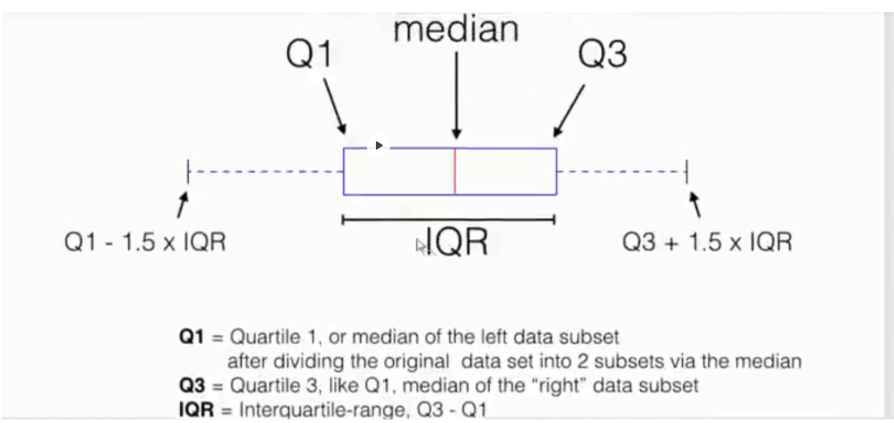4-4 盒图绘制
In [1]:
%matplotlib inline
np.random.normal()的意思是一个正态分布:numpy.random.normal(loc=0,scale=1e-2,size=shape)
- 参数loc(float):正态分布的均值,对应着这个分布的中心。loc=0说明这一个以Y轴为对称轴的正态分布,
- 参数scale(float):正态分布的标准差,对应分布的宽度,scale越大,正态分布的曲线越矮胖,scale越小,曲线越高瘦。
- 参数size(int 或者整数元组):输出的值赋在shape里,默认为None。
-
boxplot(sym = 'o', #异常点形状
vert = True, # 是否垂直
whis=1.5, # IQR
patch_artist = True, # 上下四分位框是否填充
meanline = False,showmeans = True, # 是否有均值线及其形状
showbox = True, # 是否显示箱线
showfliers = True, #是否显示异常值
notch = False, # 中间箱体是否缺口
return_type='dict') # 返回类型为字典
In [2]:
import matplotlib.pyplot as plt
import numpy as np
tang_data=[np.random.normal(0,std,100) for std in range(1,4)]
fig=plt.figure(figsize=(8,6))
plt.boxplot(tang_data,notch=False,sym='s',vert=True)
plt.xticks([y+1 for y in range(len(tang_data))],['x1','x2','x3'])
plt.xlabel('x')
plt.title('boxplot')
Out[2]:
2.设置黑白的的箱型图
In [3]:
tang_data=[np.random.normal(0,std,100) for std in range(1,4)]
fig=plt.figure(figsize=(8,6))
bplot=plt.boxplot(tang_data,notch=False,sym='s',vert=True)
plt.xticks([y+1 for y in range(len(tang_data))],['x1','x2','x3'])
plt.xlabel('x')
plt.title('boxplot')
#设置每个线条颜色
for components in bplot.keys():
for line in bplot[components]:
line.set_color('black')
3.画横的箱型图:修改参数vert=False
In [4]:
tang_data=[np.random.normal(0,std,100) for std in range(1,4)]
fig=plt.figure(figsize=(8,6))
bplot=plt.boxplot(tang_data,notch=False,sym='s',vert=False)
plt.yticks([y+1 for y in range(len(tang_data))],['x1','x2','x3'])
plt.ylabel('x')
plt.title('boxplot')
Out[4]:
4.notch = False #中间箱体是否缺口
In [5]:
tang_data=[np.random.normal(0,std,100) for std in range(1,4)]
fig=plt.figure(figsize=(8,6))
bplot=plt.boxplot(tang_data,notch=True,sym='s',vert=False)
plt.yticks([y+1 for y in range(len(tang_data))],['x1','x2','x3'])
plt.ylabel('x')
plt.title('boxplot')
Out[5]:
5.填充颜色:添加属性设置patch_artist=True,设置颜色 pathch.set_facecolor(color)
In [6]:
tang_data=[np.random.normal(0,std,100) for std in range(1,4)]
fig=plt.figure(figsize=(8,6))
bplot=plt.boxplot(tang_data,notch=False,sym='s',vert=False,patch_artist=True)#patch_artist=True上下四分位框是否填充
plt.yticks([y+1 for y in range(len(tang_data))],['x1','x2','x3'])
plt.ylabel('x')
plt.title('boxplot')
#填充颜色
colors=['pink','lightblue','lightgreen']#颜色定义
for pathch,color in zip(bplot['boxes'],colors):
pathch.set_facecolor(color)#设置颜色
小提琴图 violinplot¶
In [7]:
fig,axes=plt.subplots(nrows=1,ncols=2,figsize=(12,5))#设置小提琴图1行2列
tang_data=[np.random.normal(0,std,100)for std in range (6,10)]#设置数据
axes[0].violinplot(tang_data,showmeans=False,showmedians=True)#画小提琴图
axes[0].set_title('violin plot')
axes[1].boxplot(tang_data)#画箱型图
axes[1].set_title('box_plot')
#grid画横线
for ax in axes:
ax.yaxis.grid(True)
ax.set_xticks([y+1 for y in range(len(tang_data))])
#标注X轴lable
plt.setp(axes,xticks=[y+1 for y in range(len(tang_data))],xticklabels=['x1','x2','x3','x4'])
Out[7]:
此资源来自https://www.cnblogs.com/AI-robort/,博客园的karina512。



【推荐】编程新体验,更懂你的AI,立即体验豆包MarsCode编程助手
【推荐】凌霞软件回馈社区,博客园 & 1Panel & Halo 联合会员上线
【推荐】抖音旗下AI助手豆包,你的智能百科全书,全免费不限次数
【推荐】博客园社区专享云产品让利特惠,阿里云新客6.5折上折
【推荐】轻量又高性能的 SSH 工具 IShell:AI 加持,快人一步